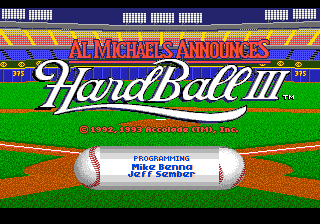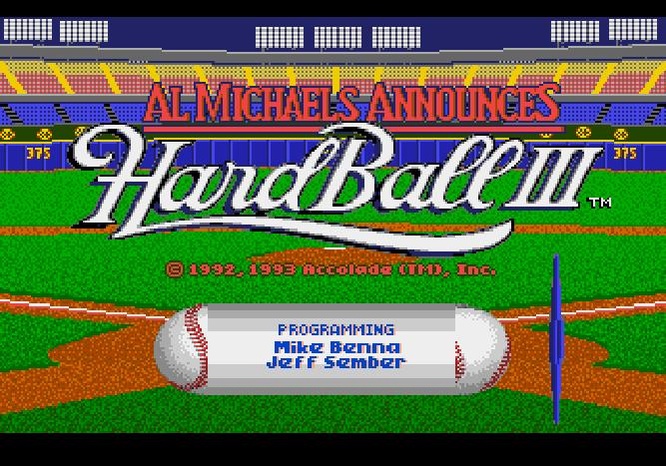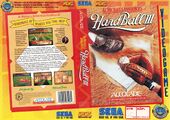Al Michaels Announces HardBall III
From Sega Retro
| Al Michaels Announces HardBall III | |||||||||||||||||||||||||||||||||||
|---|---|---|---|---|---|---|---|---|---|---|---|---|---|---|---|---|---|---|---|---|---|---|---|---|---|---|---|---|---|---|---|---|---|---|---|
| System(s): Sega Mega Drive | |||||||||||||||||||||||||||||||||||
| Publisher: Accolade | |||||||||||||||||||||||||||||||||||
| Developer: MindSpan | |||||||||||||||||||||||||||||||||||
| Distributor: Hent Gruppen (SE rental) | |||||||||||||||||||||||||||||||||||
| Genre: Sports (baseball) | |||||||||||||||||||||||||||||||||||
| Number of players: 1-2 | |||||||||||||||||||||||||||||||||||
|
This short article is in need of work. You can help Sega Retro by adding to it.
HardBall III is a baseball game for the Sega Mega Drive and a sequel (or update) to HardBall II (which skipped the console, although the original HardBall! was released for it).
It is thought the Mega Drive version was not originally officially licensed by Sega, but following the Sega v. Accolade court case, received a license during through production.
A rental version for the Nordic consumers was released, suggesting the game was probably released in Europe in small numbers.
Contents
Production credits
- Programming: Mike Benna, Jeff Sember
- Art: John Boechler
- Music: Alistair Hirst
- Producer: Pam Levins
- Developed by: MindSpan
Magazine articles
- Main article: Al Michaels Announces HardBall III/Magazine articles.
Promotional material
Physical scans
| Sega Retro Average | |||||||||||||||||||||||||||||||||||||||||||||||||||||||||||||||||||||||||||||||||||||||||||||||||||
|---|---|---|---|---|---|---|---|---|---|---|---|---|---|---|---|---|---|---|---|---|---|---|---|---|---|---|---|---|---|---|---|---|---|---|---|---|---|---|---|---|---|---|---|---|---|---|---|---|---|---|---|---|---|---|---|---|---|---|---|---|---|---|---|---|---|---|---|---|---|---|---|---|---|---|---|---|---|---|---|---|---|---|---|---|---|---|---|---|---|---|---|---|---|---|---|---|---|---|---|
|
| 75 | |
|---|---|
| Based on 19 reviews | |
Technical information
- Main article: Al Michaels Announces HardBall III/Technical information.
References
- ↑ 1.0 1.1 GamePro, "June 1993" (US; 1993-xx-xx), page 126
- ↑ Sega Pro, "Juni 1993" (DE; 1993-05-28), page 41
- ↑ 3.0 3.1 3.2 MegaTech, "June 1993" (UK; 1993-05-20), page 68
- ↑ Mean Machines Sega, "April 1993" (UK; 1993-03-26), page 102
- ↑ File:Hardball III MD credits.pdf
- ↑ Electronic Gaming Monthly, "April 1993" (US; 1993-xx-xx), page 33
- ↑ Sega Visions, "December/January 1993/1994" (US; 1993-xx-xx), page 13
- ↑ Sega Visions, "February/March 1994" (US; 199x-xx-xx), page 109
- ↑ 1700 igr dlya Sega, "" (RU; 2001-xx-xx), page 134
- ↑ Aktueller Software Markt, "Juli 1993" (DE; 1993-06-14), page 111
- ↑ Consoles +, "Avril 1993" (FR; 1993-0x-xx), page 96
- ↑ Computer & Video Games, "June 1993" (UK; 1993-05-15), page 100
- ↑ Electronic Gaming Monthly, "March 1993" (US; 1993-xx-xx), page 26
- ↑ Mean Machines: The Essential Sega Guide, "" (UK; 1993-11-18), page 56
- ↑ GamesMaster, "May 1993" (UK; 1993-04-19), page 79
- ↑ Joypad, "Avril 1993" (FR; 1993-0x-xx), page 68
- ↑ Sega Mega Drive Advanced Gaming, "June 1993" (UK; 1993-04-29), page 26
- ↑ Mega, "May 1993" (UK; 1993-04-15), page 46
- ↑ Mega Action, "June 1993" (UK; 1993-05-20), page 46
- ↑ Mega Fun, "06/93" (DE; 1993-05-19), page 28
- ↑ Mean Machines Sega, "May 1993" (UK; 1993-04-24), page 88
- ↑ Sega Power, "May 1993" (UK; 1993-04-01), page 46
- ↑ Sega Pro, "May 1993" (UK; 1993-04-08), page 45
- ↑ Sega Zone, "June 1993" (UK; 1993-05-xx), page 62
- ↑ Sega Force, "July 1993" (UK; 1993-05-27), page 32
| Al Michaels Announces HardBall III | |
|---|---|
|
Main page | Magazine articles | Reception | Region coding | Technical information | |
| HardBall games for Sega systems | |
|---|---|
| HardBall! (1991) | Al Michaels Announces HardBall III (1993) | HardBall '94 (1994) | HardBall '95 (1995) | |
| HardBall 5 (unreleased) | |
Categories:
- 1-2 player games
- US Mega Drive games
- All US games
- EU Mega Drive games
- All EU games
- DE Mega Drive games
- All DE games
- UK Mega Drive games
- All UK games
- SE Mega Drive games
- All SE games
- AU Mega Drive games
- All AU games
- Mega Drive games
- 1993 Mega Drive games
- All 1993 games
- Mega Drive baseball games
- Mega Drive sports games
- All sports games
- All games
- Stubs
- Al Michaels Announces HardBall III
- HardBall







